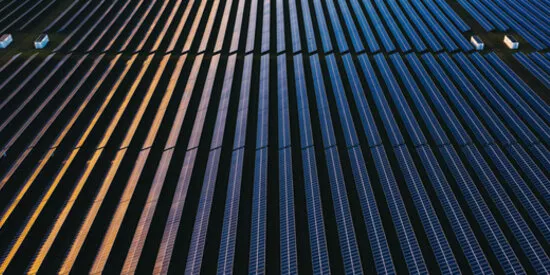
Funding India’s net-zero charge
India’s energy transition will require the full support of the public and private sectors – and billions of dollars in investment. With the right frameworks now in place, India has momentum on its side.
Toby Lawson, Chief Country Officer, India and Ben Arnott, Head of Energy Finance and Advisory, South East Asia
India has set high ambitions for the transition to a low-carbon future. At the COP26 UN climate summit in November 2021, Prime Minister Narendra Modi pledged to increase renewable energy capacity to 500 gigawatts and cut 1 billion tonnes of annual CO2 emissions by 2030 on the way to reaching net zero across the economy by 2070.1
India has the resources to make this happen. Potential generation capacity is an enormous 1,445 GW, including 750 GW of available solar capacity and a further 695 GW from wind.2
Investment in the sector has soared: India awarded contracts for 21 GW of new solar and wind capacity in 2020 alone.3 Renewable energy investment reached USD 6.6 billion between April and July 2021, according to the Institute for Energy Economics and Financial Analysis, bettering USD 6.4 billion for the entire 2020-21 fiscal year.4
Meeting the 2030 targets will require even more. The International Energy Association (IEA) estimates that India needs USD 160 billion a year to reach net zero by 2070 across its energy economy between now and 2030 – three times today's investment levels.5 And the addition of so much intermittent renewable generation requires significant upgrades to India’s existing grid and transmission infrastructure, which has suffered from decades of underinvestment.
For India to mobilise investment on such a grand scale will require a sound regulatory framework and clear government support, as well as access to a full range of local and international financing tools. Thanks to a series of positive developments over recent years, these pieces are now falling into place.
Upgrading the grid
The first phase of the government’s Green Energy Corridor scheme has proven effective at mobilising investment. The initiative, launched in 2013, links networks in seven renewables-rich states and helps connect 20 GW of renewable energy to the national grid. Based on this success, Phase 2 was announced in January 2022.6
As well as building poles and wires, policies like these are laying the foundation for an incredible build-out of green energy in India.
India’s Electricity Act of 2003 was amended last year to open the power distribution sector to private-sector competition, and India has also allowed independent power producers to bid for hybrid projects. The classification of alternative energy projects as ‘must-run’ assets also helped development to continue during the pandemic.
This regulatory support for clean energy is also deepening access to finance. Adani Transmission (ATL), the biggest private sector company in India’s power distribution sector, sealed a USD 700 million financing in October 2021 to fund transmission projects under the Green Energy Corridor in Gujarat and Maharashtra.7 The project financing is the first of its kind backed by international lenders in India’s transmission sector, and is structured to facilitate a capital markets offering once the projects are completed.
Project financing that works
ATL is the latest leading energy company to take advantage of a highly efficient financing model that combines the best features of bank lending and the debt capital markets.
Companies including Adani Green Energy, ReNew Power and Azure Power have turned to medium-term project loans from local or international banks, before seeking longer-term financing in the bond markets once the project is operational and producing income.
These structures provide the higher-risk funding required to fund the early stages of development with built-in flexibility to refinance in the capital markets once the projects are generating income. Recycling loans to bonds is also helpful for banks: the shorter maturity can help more lenders get comfortable with the risk profile and is also an efficient use of banks’ own capital, allowing lenders to recycle their funds and in turn support more projects.
Societe Generale has supported seven energy transition deals in India in the past two years. These projects mobilised total funding of USD 2.8 billion for 3.2 GW of additional renewable capacity and essential upgrades to the country’s transmission grid.
India’s progress can now serve as a template for other emerging economies that are facing the urgent need to transition away from coal power. With the right policy backdrop, the support of public and private institutions and access to multiple sources of funding, mobilising finance on the scale required for the net zero transition need not be out of reach.
1 https://climateactiontracker.org/countries/india/
2 https://mnre.gov.in/wind/current-status/
3 https://cef.ceew.in/solutions-factory/CEEW-CEF-clean-energy-investment-trends-2021.pdf
4 https://ieefa.org/ieefa-renewable-energy-investment-in-india-bounces-back-from-covid-19-slowdown/
5 https://www.iea.org/commentaries/india-s-clean-energy-transition-is-rapidly-underway-benefiting-the-entire-world
6 https://pib.gov.in/PressReleaseIframePage.aspx?PRID=1788011
7 https://www.adanitransmission.com/newsroom/media-releases/Adani-Transmission-raises-USD-700-Mn-in-one-of-Asias-largest-revolving-project-financing-deals




